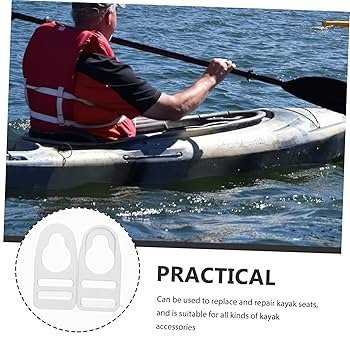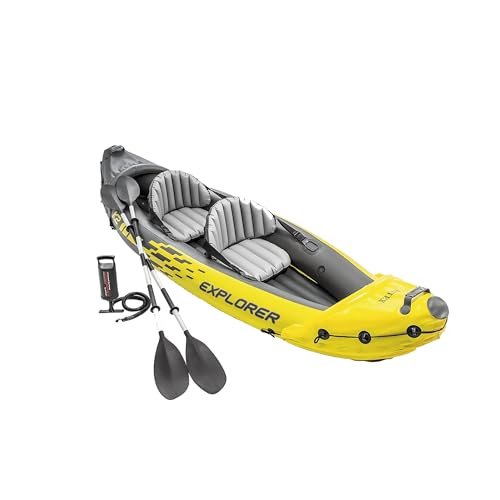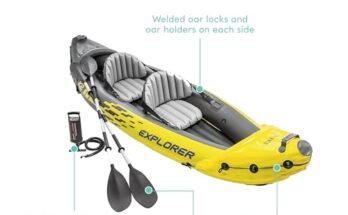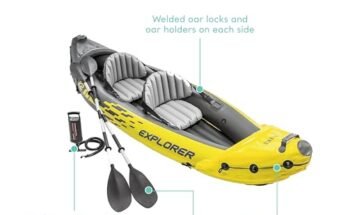Is your kayak seat causing discomfort or wobbling every time you paddle? Fixing it might seem tricky, but you don’t have to struggle or spend a fortune on replacements.
In this guide, you’ll discover simple, practical steps to repair your kayak seat quickly and get back on the water with confidence. Keep reading, and you’ll learn how to make your seat stable and comfortable again—so your next trip is all about fun, not frustration.

Identify Common Seat Issues
Kayak seats can wear out from regular use. Fixing them improves comfort and safety. Let’s look at common problems to watch for.
Knowing the issues helps you decide what repairs you need. Some fixes are simple, while others may need parts replaced.
Loose Straps And Buckles
Straps and buckles keep the seat in place. If they loosen, the seat may move or slip while paddling.
- Check if straps have frayed edges.
- Test buckles to see if they lock securely.
- Look for missing or broken adjustment parts.
- Tighten or replace any loose components.
Torn Or Worn Fabric
The fabric on your kayak seat can tear or wear thin over time. This causes discomfort and less support.
| Fabric Problem | Signs | Fix |
| Small tears | Holes or rips | Use fabric glue or patches |
| Worn spots | Thinning or fuzziness | Replace fabric or seat cover |
| Loose stitching | Threads coming undone | Sew or reinforce stitching |
Broken Frame Components
The frame gives the seat its shape. Broken parts can make the seat unstable or unusable.
Check the frame for:
- Cracks in metal or plastic parts
- Loose or missing screws and bolts
- Bent or warped support bars
Repair options include tightening screws, welding cracks, or replacing damaged parts.
Gather Essential Repair Tools
Fixing a kayak seat needs the right tools. Gathering these tools first makes the job easier.
Having the correct repair items helps you fix the seat properly and safely.
Basic Repair Kit
A basic repair kit has the main tools for small fixes. It helps you handle most seat repairs.
Keep these tools ready to save time and avoid frustration during repairs.
- Screwdrivers (flathead and Phillips)
- Adjustable wrench
- Utility knife or scissors
- Sandpaper (medium grit)
- Measuring tape
- Cleaning cloths
Replacement Parts
Seats may need new parts if old ones break. Having spare parts helps fix the seat quickly.
Check the kayak seat for worn or damaged pieces before starting repairs.
- Seat straps or buckles
- Foam padding or cushions
- Seat covers or fabric
- Bolts, nuts, and washers
- Plastic or metal brackets
Adhesives And Sealants
Adhesives and sealants hold parts together and keep water out. Choose the right type for your kayak.
Use products that work well with plastic and marine environments for lasting repairs.
- Waterproof marine adhesive
- Epoxy resin for strong bonds
- Silicone sealant to prevent leaks
- Contact cement for fabric repairs
- Plastic welding glue
Fix Loose Straps And Buckles
Loose straps and buckles can make your kayak seat uncomfortable and unsafe. Fixing them keeps your seat secure and stable while paddling.
This guide helps you tighten straps and replace damaged buckles easily. Use simple tools and parts to get your seat ready again.
Tightening Techniques
Start by checking all straps for slack. Tighten each strap to hold the seat firmly in place. Use the following methods:
- Pull the strap through the buckle to remove slack.
- Hold the strap tight and press the buckle to lock it.
- Adjust the strap length for comfort and support.
- Tie off excess strap to prevent flapping.
Regularly inspect straps for wear or stretching. Replace any strap that no longer holds tension well.
Replacing Damaged Buckles
Damaged buckles reduce safety and function. Replace broken buckles quickly to avoid accidents. Follow these steps:
| Step | Action | Tools Needed |
| 1 | Remove the damaged buckle by cutting or unthreading the strap. | Scissors or knife |
| 2 | Purchase a matching replacement buckle. | None |
| 3 | Thread the strap through the new buckle. | None |
| 4 | Tighten the strap and test the buckle’s hold. | Hands |

Repair Torn Seat Fabric
Torn kayak seat fabric can make paddling uncomfortable. Fixing it keeps your seat strong and dry.
There are simple ways to repair torn fabric. You can patch, sew, or use waterproof glue.
Patch Application
Patching is a quick way to cover big tears. Use a strong fabric patch that sticks well to the seat.
Clean the area first and cut the patch slightly bigger than the tear. Press it firmly on the seat fabric.
- Clean seat fabric with mild soap and water
- Dry completely before patching
- Cut patch 1-2 inches larger than the tear
- Press patch firmly to avoid bubbles
Sewing Small Tears
Sewing works well for small tears or cracks. Use a strong needle and waterproof thread for best results.
Stitch the edges carefully without making holes bigger. Use small, tight stitches to keep the fabric secure.
- Use nylon or polyester thread
- Choose a curved needle if needed
- Stitch from the inside for a clean look
- Tie knots tightly to prevent unraveling
Using Waterproof Fabric Glue
Waterproof fabric glue seals tears without sewing. It works well on small to medium rips in kayak seats.
Apply glue to the torn edges and press them together. Let the glue dry fully before using the kayak.
- Choose glue made for outdoor fabrics
- Apply a thin, even layer on both sides
- Hold fabric edges together while drying
- Allow 24 hours for full cure time
Restore Broken Frame Parts
A broken kayak seat frame can stop you from enjoying your trip. Fixing it helps you get back on the water quickly. Knowing how to restore frame parts saves money and effort.
In this guide, you will learn how to check for damage, apply temporary fixes, and replace the frame permanently.
Assessing Frame Damage
Start by examining the kayak seat frame carefully. Look for cracks, bends, or broken pieces. Check if the frame still holds its shape.
Test the seat by sitting on it gently. Notice any wobbling or weakness. This helps find hidden damage that may need repair.
- Look for visible cracks or breaks
- Check bent or twisted frame parts
- Test frame stability by applying pressure
- Find loose or missing screws and bolts
Temporary Fixes
You can use simple tools to fix the frame temporarily. This helps keep the seat usable until you can do a full repair. Use tape, clamps, or zip ties to hold parts together.
Make sure temporary fixes are tight and secure. Avoid sitting on the seat if it feels unsafe. Use these fixes only for short trips or emergencies.
- Wrap broken parts with strong duct tape
- Use zip ties to hold loose sections
- Clamp bent metal to keep shape
- Avoid heavy use with temporary repairs
Permanent Frame Replacement
For a lasting fix, replace the broken frame parts. Buy new parts that fit your kayak seat model. Remove damaged parts carefully before installing replacements.
Use proper tools and follow instructions to assemble the new frame. Check all bolts and screws are tight. Test the seat for comfort and safety before use.
- Purchase correct frame parts for your seat
- Remove damaged parts with proper tools
- Attach new parts securely with screws or bolts
- Test seat stability and comfort after repair

Prevent Future Seat Damage
Kayak seats can wear out over time. Taking care of your seat is important. This guide helps you keep your kayak seat in good condition.
Learn simple tips to prevent damage. These steps will ensure your seat lasts longer. Follow them to enjoy a comfortable kayaking experience.
Regular Maintenance Tips
Regular maintenance keeps your kayak seat in top shape. Checking your seat often helps find small issues before they become big problems.
- Inspect seat for tears or wear before each use
- Clean the seat with mild soap and water after kayaking
- Tighten any loose straps or buckles
- Apply a UV protectant spray to shield from sun damage
Proper Storage Practices
Storing your kayak correctly helps prevent seat damage. Make sure to store it in a safe and dry place.
- Keep kayak indoors or under a cover
- Store it on a rack to avoid pressure on the seat
- Ensure the storage area is dry to prevent mold
- Remove the seat when storing for long periods
Upgrading To Durable Materials
Consider upgrading your seat to more durable materials. This can enhance comfort and longevity.
Durable materials withstand harsh conditions better. They provide better support and can make long trips more enjoyable.
- Look for seats made of high-quality neoprene
- Choose seats with reinforced stitching
- Consider seats with extra padding for comfort
- Research options with adjustable back support
Frequently Asked Questions
How Do I Repair A Torn Kayak Seat?
To repair a torn kayak seat, use a strong adhesive patch designed for fabric. Clean the area, apply the patch, and let it dry. This prevents further tearing and restores comfort quickly.
What Tools Are Needed To Fix Kayak Seat Straps?
You need a screwdriver, replacement straps, sewing kit, and heavy-duty glue. These tools help tighten, replace, or secure loose or broken straps effectively.
Can I Replace The Entire Kayak Seat Myself?
Yes, you can replace the seat by removing old bolts and straps. Measure the new seat properly and install it securely for safe use.
How To Fix A Sagging Kayak Seat?
Tighten or replace the seat straps to remove sagging. Adding extra padding can also improve comfort and support during paddling.
Conclusion
Fixing your kayak seat can improve comfort and safety on the water. Small repairs like tightening screws or replacing foam make a big difference. Regular checks help spot problems early. Taking care of the seat extends your kayak’s life. Enjoy your paddling trips without discomfort or distractions.
Simple steps keep your seat sturdy and ready. Keep tools handy and fix issues as they come. A well-maintained seat means more fun and less hassle. Try these tips to keep your kayak seat in good shape.



